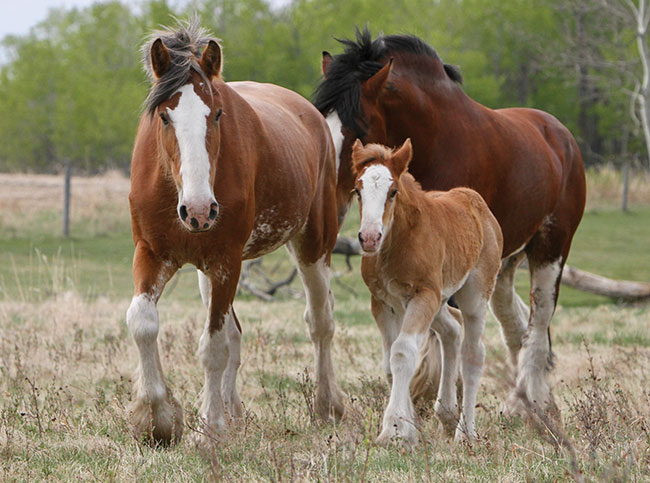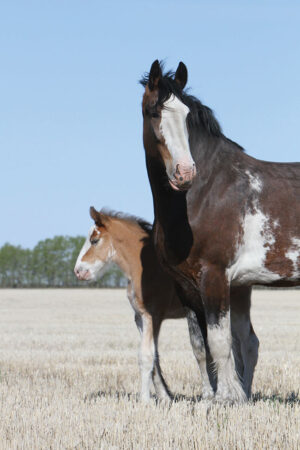
Features
Animal Health
From well-fed foals sturdy horses grow
By Rosalie Tenison
Helping foals transition to solid food requires a plan to sustain healthy development.
 Clydesdale foal at various stages of growth in Alberta.
Image courtesy of Willow Way Clydesdales.
Clydesdale foal at various stages of growth in Alberta.
Image courtesy of Willow Way Clydesdales. No matter what use you intend for your horses, whether riding, driving, racing or any other purpose, achieving the sturdiest, healthiest animal for their intended role starts when they are babies. In fact, one equine specialist suggests raising healthy horses starts before they are born by caring for the pregnant mare.
“We need to think about the mare and make sure she has a solid plane of nutrition,” says Amanda Van De Kerckhove, a nutritionist with Federated Co-operatives Limited in Saskatoon, Sask. “You want the pregnant mare to be getting adequate micronutrients – amino acids, vitamins and minerals – in addition to her macro nutrition like energy and fibre.”
Keeping the mare at a healthy weight by giving her balanced nutrition will guarantee healthy fetal growth, she adds. When the time comes, a sound mare will deliver a sturdy, lively foal.
Until weaning, ensuring the mare continues on a healthy diet, will give the foal much of what it needs through mom’s milk. But, eventually, the baby will begin copying the mare and start tasting grass or hay or whatever its mother is enjoying. At this point, paying attention to the foal’s nutrition will guarantee it becomes the horse you want it to be.
Feeding an animal that grows like a weed
According to University of Nebraska–Lincoln extension horse specialist, Dr. Kathleen Anderson, foals reach a high percentage of their height and weight between weaning and one year, so ensuring they have the nutrition to support and encourage that growth is important.
“Foals can reach 67 per cent of their height in 12 months,” explains Anderson. “There is a lot of skeletal development and, if they don’t get good nutrition early on, they won’t reach their potential or have the strongest feet and legs.”
Understanding a foal’s growth, particularly if you are new to equine care, is critical. Anderson advises caring for your foal from the ground up. Encouraging strong legs is tantamount so the adult horse can withstand whatever workload you give it.
“We use them to carry weight, so they need strong legs,” points out Anderson.
While nibbling grass like the mare or tasting her food will not hurt the foal, those food choices may not be enough to develop their bodies. Equine nutritionists recommend planning a diet for the growing foal that will set them on the track to maturity.
“By two to three months of age, foals may need more energy and protein in their diet,” advises Dr. Priska Darani, the director of research at Mad Barn, a company that focusses on equine nutrition in Kitchener, Ont.
When planning a nutrition program for your new foal, she says, it is important to take note of the time of year that the foal will be needing good food. A foal born early in the year might not have good pasture available, so hay and other feed may be needed. Foals born in late spring should have access to rich pasture and won’t require supplemental hay. Eventually most foals will need some form of feed to promote healthy, steady growth.
“Consider soybean meal, which is a good source of protein, or soft alfalfa hay or alfalfa pellets,” advises Darani. “After weaning, you need to monitor the foal’s growth and adjust its feed accordingly. Get your hay analysed and work with an equine nutritionist to adjust what you are feeding the foal to ensure a balanced diet.”

A foal alongside its mother in Alberta.
Image courtesy of Willow Way Clydesdales.
Consistency is key
If foals grow too fast, they can develop joint issues. Watch for the development of physitis, an inflammation of the growth plates that is fairly common in foals. Physitis has been linked to rapid growth rates potentially from too much energy derived from feed. This condition is less of a problem than believed and, often, self-resolves, according to Van De Kerckhove.
In the past, treatment for physitis was often to remove concentrate feed, but that could ultimately result in reduced micronutrient supply, potentially stunting development of the foal. She says maintaining consistency in the foal’s diet and monitoring of growth is all that is needed.
Hopefully, the foal will thrive on mother’s milk and the occasional nibble of pasture, but Van De Kerckhove says regular monitoring of horses is necessary in case the foal is not getting enough nutrition from milk. She says keeping the mare healthy through the foal’s development should keep the family nutritionally sound. In some cases, however, if the foal is struggling in its first three months, a supplement of foal milk replacer or milk pellets will keep the youngster on track. Be sure to use a horse-specific product to ensure the right kind of nutrition, she adds.
“Once the foal is past three months, they are capable of eating a half to one per cent of their body weight in feed pellets,” adds Van De Kerckhove. “At this point you can introduce 16 to 18 per cent crude protein pellet into their diet. Always be sure the feed you are supplying is meant for foals.”
Anderson suggests “creep feeding” if you want to ensure the foal is getting all the feed it requires. In order to facilitate this method, the foal needs access to its own feed in a way not available to the mare.
She suggests using the formula of one pound of grain for each month in age. So, at three months, the foal could be given three pounds of food. She recommends 60 to 70 per cent of the foal’s diet should be grain with the remaining percentage in forage. “This will change as they get older because their growth rate slows as they age,” she explains. “Close observation of your foal will give you an idea of what they are needing and when. Watch them and gauge their health by running your hands over them.”
Weaning strategies
Weaning is a shock to foals and the change in diet can cause their growth to stall. Starting them on a diet of their own prior to weaning may help with the separation anxiety they might experience when mom’s milk is no longer available.
“Start foals on the food they will get post-weaning and this may help them adjust,” advises Dr. Darani. “Slow- to medium-paced growth is often considered ideal and working with a nutritionist can assist you in monitoring your foal’s progress and minimize any issues that could affect them the rest of their lives.” Creep feeding before weaning could also help with the adjustment to eating on their own.
“You need to give foals a good supply of protein for muscle development,” adds Darani. “In addition, they need minerals for bone health and overall development. Avoid feeding lots of starch and sugars from grains, like wheat, barley and corn.”
Van De Kerckhove recommends regular monitoring as well, but she doesn’t believe creep feeding is necessary all the time. She says good nutrition is a controllable tool and offering a nutrient dense feed to foals and mares at the same time in separate feeding stations is a good alternative to creep feeding. She is more concerned in maintaining balance of nutrition because there truly is “too much of a good thing.” It’s important, she stresses, to target consistent growth with feed containing the necessary vitamins, amino acids and minerals.
“Be committed to the first 18 months of your foal’s life feeding a good balance of nutrition and ensuring regular exercise for developing healthy bones and you will end up with a sturdy, healthy animal that will do the work you ask it to do,” concludes Van De Kerckhove.
In her final thoughts on foal nutrition, Anderson says her “bottom line” is to “leave them turned out as much as you can because exercise is good as it develops their bones, and creep feed or ensure a balance of nutrition. Just make sure your young horses are getting what they need.”
All the nutrition experts agree that raising a healthy foal comes down to diet and exercise, but consistent monitoring and managing the dietary needs of the foal will ensure success.
Print this page